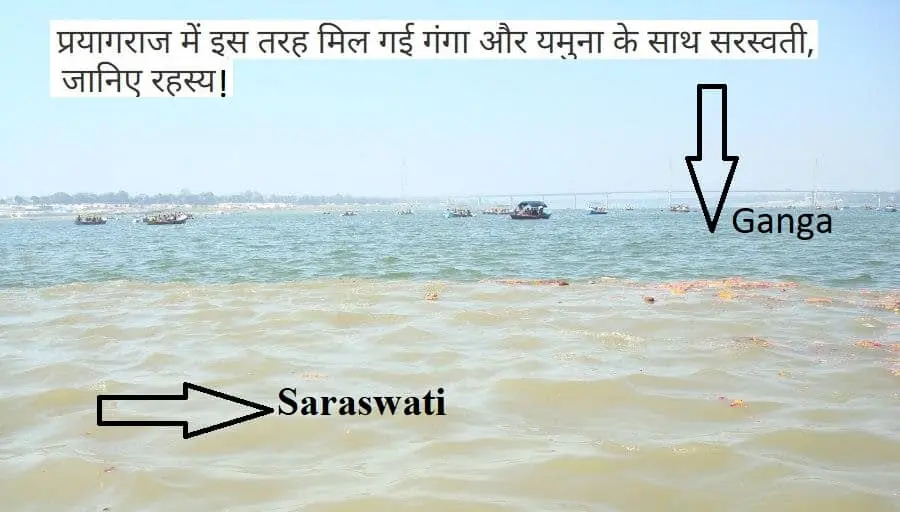The confluence of the Ganga, Yamuna, and Saraswati rivers, known as the Ganga Yamuna Saraswati Sangam, holds a sacred and spiritual significance in the heart of Allahabad. This revered meeting point, considered highly auspicious in Hindu mythology, is a testament to the city’s cultural and religious heritage. Pilgrims from far and wide converge at this hallowed junction to partake in ritualistic bathing during the Kumbh Mela, a colossal gathering that occurs every twelve years, reinforcing Allahabad’s role as a spiritual center. The Sangam not only symbolizes the intertwining of these mighty rivers but also serves as a metaphor for the diverse cultural currents that have shaped Allahabad’s identity over the centuries.
What is Sangam?
“Sangam” usually means an old-time meeting of poets that happened in the southern part of India, especially in a place now called Tamil Nadu. The word “Sangam” comes from the Tamil language and means a gathering or a meeting.
The Sangam time, thought to be from about 300 BCE to 300 CE, is famous for its great literary work. At these gatherings, poets and smart people would come together to talk and write poems about different things like love, war, nature, and good behavior. The Sangam writings, which include poems and texts, tell us a lot about how ancient Tamil society was, its culture, and its politics.
The Sangam era is split into three parts: the Early Sangam time, the Middle Sangam time, and the Later Sangam time. Each part helped make Tamil literature better and kept the cultural history alive. People really like the Sangam poems because they are considered top-notch for their art and literary qualities.
What is Triveni Sangam?
Triveni Sangam holds significant cultural and religious importance in India, representing the convergence of three rivers. The term “Triveni” denotes the meeting point of three, while “Sangam” refers to the confluence. The renowned Triveni Sangam is situated in Allahabad, now known as Prayagraj, where the sacred rivers Ganges, Yamuna, and the mythical Saraswati intersect.
In Hinduism, this confluence is rever as a sacred site, and it is believ that taking a dip in the Triveni Sangam during specific auspicious occasions cleanses individuals of sins and imparts spiritual merit. The Kumbh Mela, one of the largest religious gatherings globally, is hosted at the Triveni Sangam every 12 years, attracting millions of pilgrims from far and wide. This grand event is a testament to the cultural and spiritual significance attached to the Triveni Sangam, making it a focal point for devout Hindus seeking purification and divine blessings.
Ganga, Yamuna, and Saraswati, considered holy in Hinduism, flow through the diverse landscapes of India, carrying tales of ancient times. The confluence of Ganga and Yamuna is visibly striking, their distinct colors blending in a mesmerizing spectacle. However, the enigma deepens with the elusive third river, Saraswati, leaving many to ponder its mysterious merging.
The rivers Ganga, Yamuna, Saraswati, Kaveri, Godavari, Krishna, Sindhu, Shipra, and Brahmaputra all possess their distinct confluences. Hinduism revolves around three principal deities—Brahma, Vishnu, and Shiva—and three primary goddesses—Lakshmi, Saraswati, and Parvati. This is why Triveni, symbolizing the convergence of three rivers, holds immense significance throughout India.
Triveni marks the point where three rivers merge, and this phenomenon is rever in various parts of the country. The sacred Ganga River, for instance, flowing through Prayag, features a notable Triveni where three rivers meet. This convergence not only holds geographical importance but also carries deep spiritual and religious significance in Hindu culture. The confluence of these rivers becomes a symbol of unity and divine connection, reflecting the broader religious beliefs embedded in the cultural fabric of India.
Sangam, also known as Triveni, marks the specific location where the Ganga, Yamuna, and Saraswati rivers converge. This unique confluence at Sangam is renowned worldwide. While Ganga and Yamuna have long held cultural and religious significance, the river Saraswati has also gained importance in Indian culture. The intriguing aspect arises when considering the merging of these rivers. The distinct color contrast between Ganga and Yamuna makes their confluence visibly discernible. However, the mysterious river Saraswati poses a question: where and how does it merge? Unraveling the merging point of Saraswati adds an element of mystery to this sacred convergence, prompting inquiry into the intricacies of its course and meeting with the other two rivers.
The enigma surrounding the convergence of the Ganga, Yamuna, and Saraswati rivers finds an explanation. In the detailed accounts of the Shrimad Bhagwat Puran. In ancient times, the Saraswati River flowed through the Saurashtra region, which once included the entire Marwar area. It gracefully traversed this landscape, becoming a focal point for daily worship rituals. As the ages passed, a cultural shift occurred when the residents of this region embraced the beliefs and culture of the ‘Yavan’ people.
In response to these changes, the holy river Saraswati sought permission from Brahmaji to depart. From the Marwar and Saurashtra regions, eventually finding its new abode in Prayag. The departure of Saraswati had profound consequences for the abandoned regions, transforming them into the arid desert landscape known today as Rajasthan. This narrative not only elucidates the historical movement of the Saraswati River but also highlights the cultural transitions that shaped the destiny of these regions. The sacred river’s journey and its relocation to Prayag add layers of significance to the confluence of the three rivers, weaving a tale that intertwines geography, culture, and spirituality.

Ganga Yamuna Saraswati Sangam The Rigveda provides a vivid portrayal of the sacred Saraswati River. Characterizing it as Annavati and Udakvati, emphasizing its role as a source of nourishment and provider of sustenance. According to the Rigveda, the river flows to the east of Yamuna and to the west of Sutlej. In the Mahabharata, Saraswati assumes various names such as Plakshvati, Vedsmriti, and Vedvati. However, alternative sources like Tandaya and Jaiminiya Brahmana present a contrasting depiction, describing the Saraswati as a dry desert land.
The Mahabharata, an iconic epic, pinpoints the disappearance of the Ganga Yamuna Saraswati Sangam River at a place called “Vinashan.” This location once host the banks of the river, where Brahmavarta and Kurukshetra were situat. Today, a reservoir occupies this space, signifying a transformation in the landscape over time. The Mahabharata further narrates the journey of Balram from Dwarka to Mathura via the Saraswati River. Highlighting its historical significance as a travel route. Additionally, after the battle. The Yadava mortal remain were said to be immers in the waters of the Saraswati. Indicating its presence during that era and its utilization for ceremonial purposes and transportation. This rich tapestry of references in ancient texts paints a dynamic picture of the Saraswati River, showcasing its multifaceted roles and historical importance.
How Did Saraswati Converge into Ganga?
During Vedic times, the existence of the Drishdwati River was mention, serving as an assisting river to the Saraswati. Both these rivers flowed through Haryana. A seismic event, a massive earthquake, shook the regions of Haryana and Rajasthan. Causing upheavals that elevated the underlying mountains above the ground. This geological transformation led to alterations in the courses of rivers.
While the Saraswati vanished, the Drishdwati also experienced a change in its flow. The present-day Yamuna is believed to be the transform course of the ancient Drishdwati. Approximately 4,000 years ago, the earthquake caused a rise in the land. Diverting half of the Saraswati’s waters into the Yamuna, leading to their confluence. This convergence is what lends significance to Prayag as the meeting point of three rivers.
Religious scriptures, including the Mahabharata, mention seven rivers named Saraswati. One Saraswati river, flowing alongside the Yamuna, used to merge with the Ganga. In Brajmandal, historical records indicate a Saraswati river from the ancient state of Haryana flowing through. Ambika Van near the Gokarneshwar Mahadev temple, joining the Yamuna at ‘Saraswati Sangam Ghat’. Puranas also reference the Saraswati River and Ambika Van near its proximity.
Also Read : The worst ipl team
Although the ancient Saraswati no longer follows its original course, a monsoon stream. With the same name now flows through the former Ambika Van spot. It proceeds towards the Mahavidya forest to meet the Yamuna. With the existence of Saraswati Kund, Nala, Mandir, and Ghat providing evidence of the ancient river stream. The traditions of Braj are intertwin with its prehistoric origins. As mentioned in the Swayambhuva Manu. The historical Swami Ghat in Mathura was originally known as Sanyaman Ghat.




